Robert Gordon University: BSM018 - UK Economy Analysis Report
VerifiedAdded on 2022/08/22
|10
|2184
|18
Report
AI Summary
This report provides a comprehensive analysis of the UK's economic condition, examining key indicators such as GDP growth rate, inflation, and unemployment. It delves into the challenges of economic slowdown since 2014, exploring the need for effective stimulus policies. The report thoroughly investigates both fiscal and monetary policies, discussing the implications of expansionary fiscal measures like tax rate reductions and increased government expenditure in sectors like health and education. It also analyzes the role of monetary policy, including base rates, cash reserve ratios, and open market operations, in stimulating economic growth. The report concludes by emphasizing the potential impact of implementing both expansionary fiscal and monetary policies to boost the UK's GDP growth and mitigate the risk of recession.
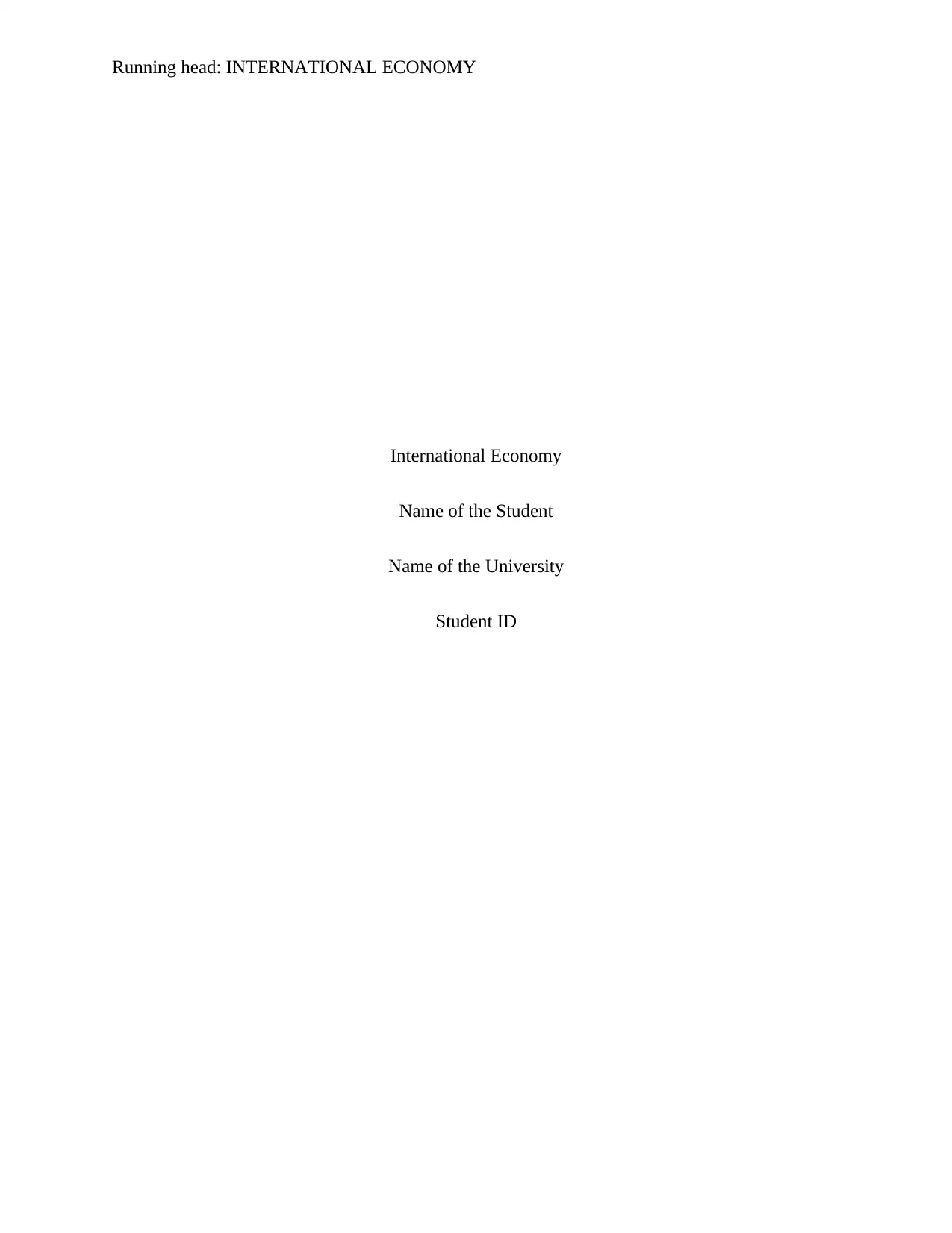
Running head: INTERNATIONAL ECONOMY
International Economy
Name of the Student
Name of the University
Student ID
International Economy
Name of the Student
Name of the University
Student ID
Paraphrase This Document
Need a fresh take? Get an instant paraphrase of this document with our AI Paraphraser
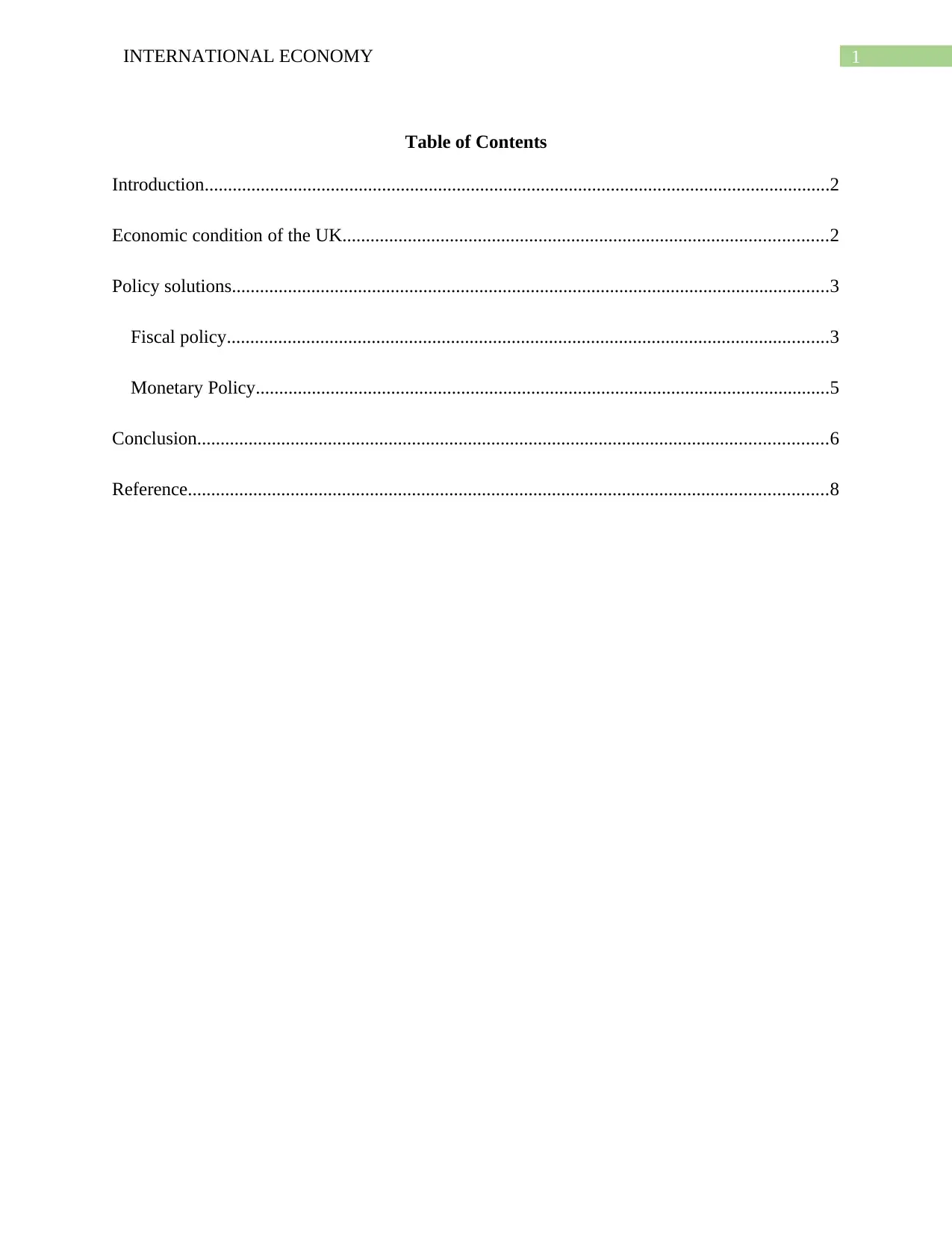
1INTERNATIONAL ECONOMY
Table of Contents
Introduction......................................................................................................................................2
Economic condition of the UK........................................................................................................2
Policy solutions................................................................................................................................3
Fiscal policy.................................................................................................................................3
Monetary Policy...........................................................................................................................5
Conclusion.......................................................................................................................................6
Reference.........................................................................................................................................8
Table of Contents
Introduction......................................................................................................................................2
Economic condition of the UK........................................................................................................2
Policy solutions................................................................................................................................3
Fiscal policy.................................................................................................................................3
Monetary Policy...........................................................................................................................5
Conclusion.......................................................................................................................................6
Reference.........................................................................................................................................8
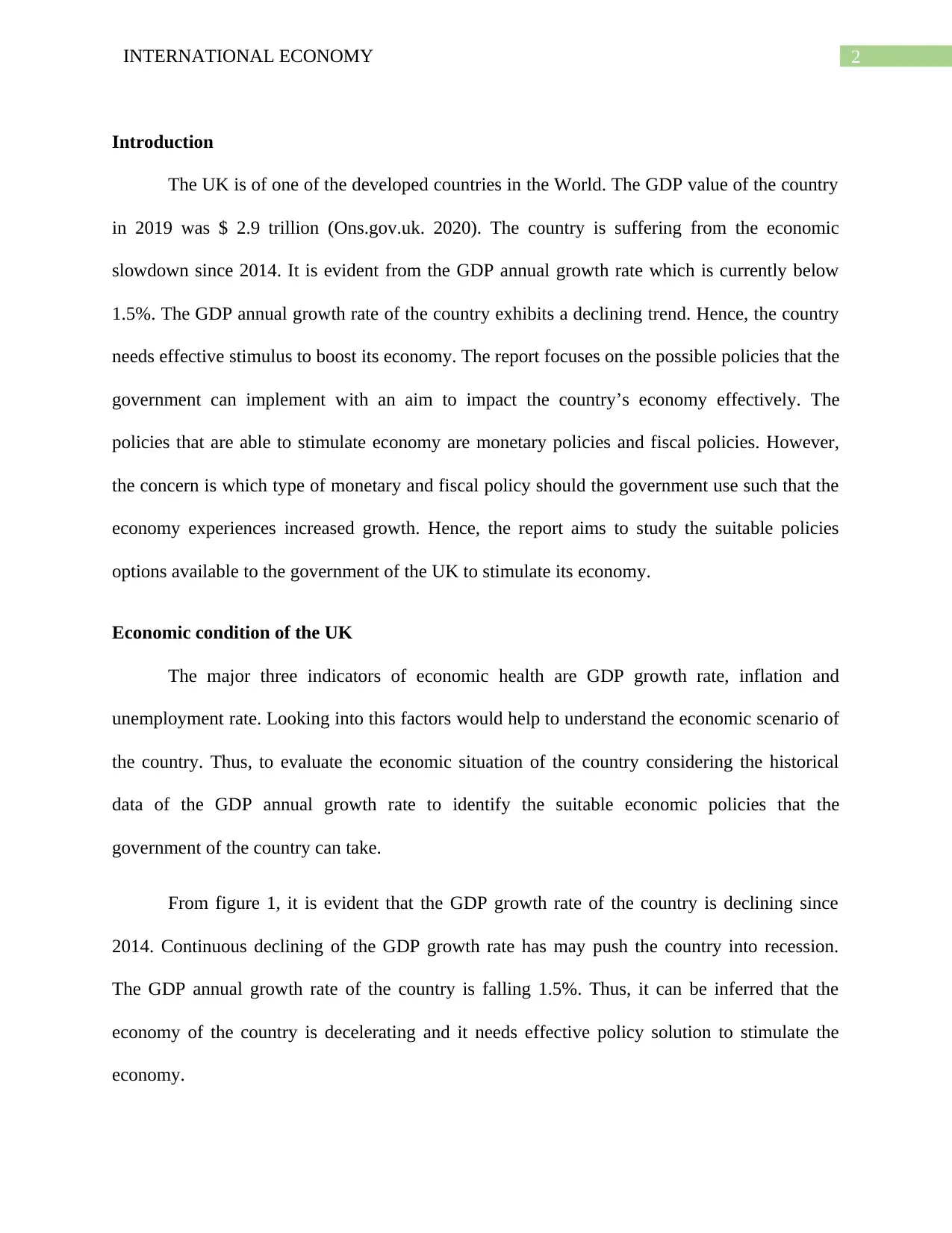
2INTERNATIONAL ECONOMY
Introduction
The UK is of one of the developed countries in the World. The GDP value of the country
in 2019 was $ 2.9 trillion (Ons.gov.uk. 2020). The country is suffering from the economic
slowdown since 2014. It is evident from the GDP annual growth rate which is currently below
1.5%. The GDP annual growth rate of the country exhibits a declining trend. Hence, the country
needs effective stimulus to boost its economy. The report focuses on the possible policies that the
government can implement with an aim to impact the country’s economy effectively. The
policies that are able to stimulate economy are monetary policies and fiscal policies. However,
the concern is which type of monetary and fiscal policy should the government use such that the
economy experiences increased growth. Hence, the report aims to study the suitable policies
options available to the government of the UK to stimulate its economy.
Economic condition of the UK
The major three indicators of economic health are GDP growth rate, inflation and
unemployment rate. Looking into this factors would help to understand the economic scenario of
the country. Thus, to evaluate the economic situation of the country considering the historical
data of the GDP annual growth rate to identify the suitable economic policies that the
government of the country can take.
From figure 1, it is evident that the GDP growth rate of the country is declining since
2014. Continuous declining of the GDP growth rate has may push the country into recession.
The GDP annual growth rate of the country is falling 1.5%. Thus, it can be inferred that the
economy of the country is decelerating and it needs effective policy solution to stimulate the
economy.
Introduction
The UK is of one of the developed countries in the World. The GDP value of the country
in 2019 was $ 2.9 trillion (Ons.gov.uk. 2020). The country is suffering from the economic
slowdown since 2014. It is evident from the GDP annual growth rate which is currently below
1.5%. The GDP annual growth rate of the country exhibits a declining trend. Hence, the country
needs effective stimulus to boost its economy. The report focuses on the possible policies that the
government can implement with an aim to impact the country’s economy effectively. The
policies that are able to stimulate economy are monetary policies and fiscal policies. However,
the concern is which type of monetary and fiscal policy should the government use such that the
economy experiences increased growth. Hence, the report aims to study the suitable policies
options available to the government of the UK to stimulate its economy.
Economic condition of the UK
The major three indicators of economic health are GDP growth rate, inflation and
unemployment rate. Looking into this factors would help to understand the economic scenario of
the country. Thus, to evaluate the economic situation of the country considering the historical
data of the GDP annual growth rate to identify the suitable economic policies that the
government of the country can take.
From figure 1, it is evident that the GDP growth rate of the country is declining since
2014. Continuous declining of the GDP growth rate has may push the country into recession.
The GDP annual growth rate of the country is falling 1.5%. Thus, it can be inferred that the
economy of the country is decelerating and it needs effective policy solution to stimulate the
economy.
⊘ This is a preview!⊘
Do you want full access?
Subscribe today to unlock all pages.

Trusted by 1+ million students worldwide
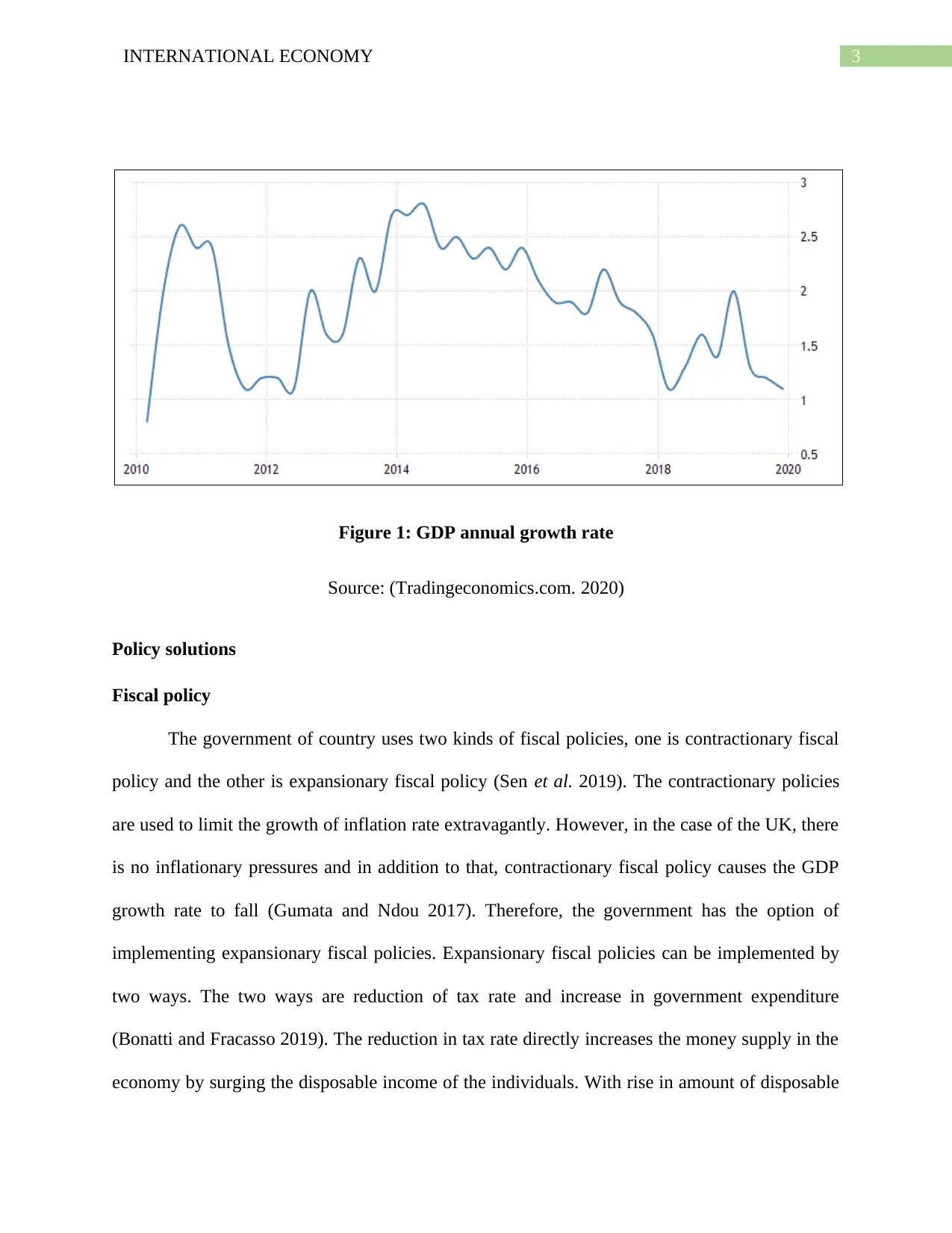
3INTERNATIONAL ECONOMY
Figure 1: GDP annual growth rate
Source: (Tradingeconomics.com. 2020)
Policy solutions
Fiscal policy
The government of country uses two kinds of fiscal policies, one is contractionary fiscal
policy and the other is expansionary fiscal policy (Sen et al. 2019). The contractionary policies
are used to limit the growth of inflation rate extravagantly. However, in the case of the UK, there
is no inflationary pressures and in addition to that, contractionary fiscal policy causes the GDP
growth rate to fall (Gumata and Ndou 2017). Therefore, the government has the option of
implementing expansionary fiscal policies. Expansionary fiscal policies can be implemented by
two ways. The two ways are reduction of tax rate and increase in government expenditure
(Bonatti and Fracasso 2019). The reduction in tax rate directly increases the money supply in the
economy by surging the disposable income of the individuals. With rise in amount of disposable
Figure 1: GDP annual growth rate
Source: (Tradingeconomics.com. 2020)
Policy solutions
Fiscal policy
The government of country uses two kinds of fiscal policies, one is contractionary fiscal
policy and the other is expansionary fiscal policy (Sen et al. 2019). The contractionary policies
are used to limit the growth of inflation rate extravagantly. However, in the case of the UK, there
is no inflationary pressures and in addition to that, contractionary fiscal policy causes the GDP
growth rate to fall (Gumata and Ndou 2017). Therefore, the government has the option of
implementing expansionary fiscal policies. Expansionary fiscal policies can be implemented by
two ways. The two ways are reduction of tax rate and increase in government expenditure
(Bonatti and Fracasso 2019). The reduction in tax rate directly increases the money supply in the
economy by surging the disposable income of the individuals. With rise in amount of disposable
Paraphrase This Document
Need a fresh take? Get an instant paraphrase of this document with our AI Paraphraser
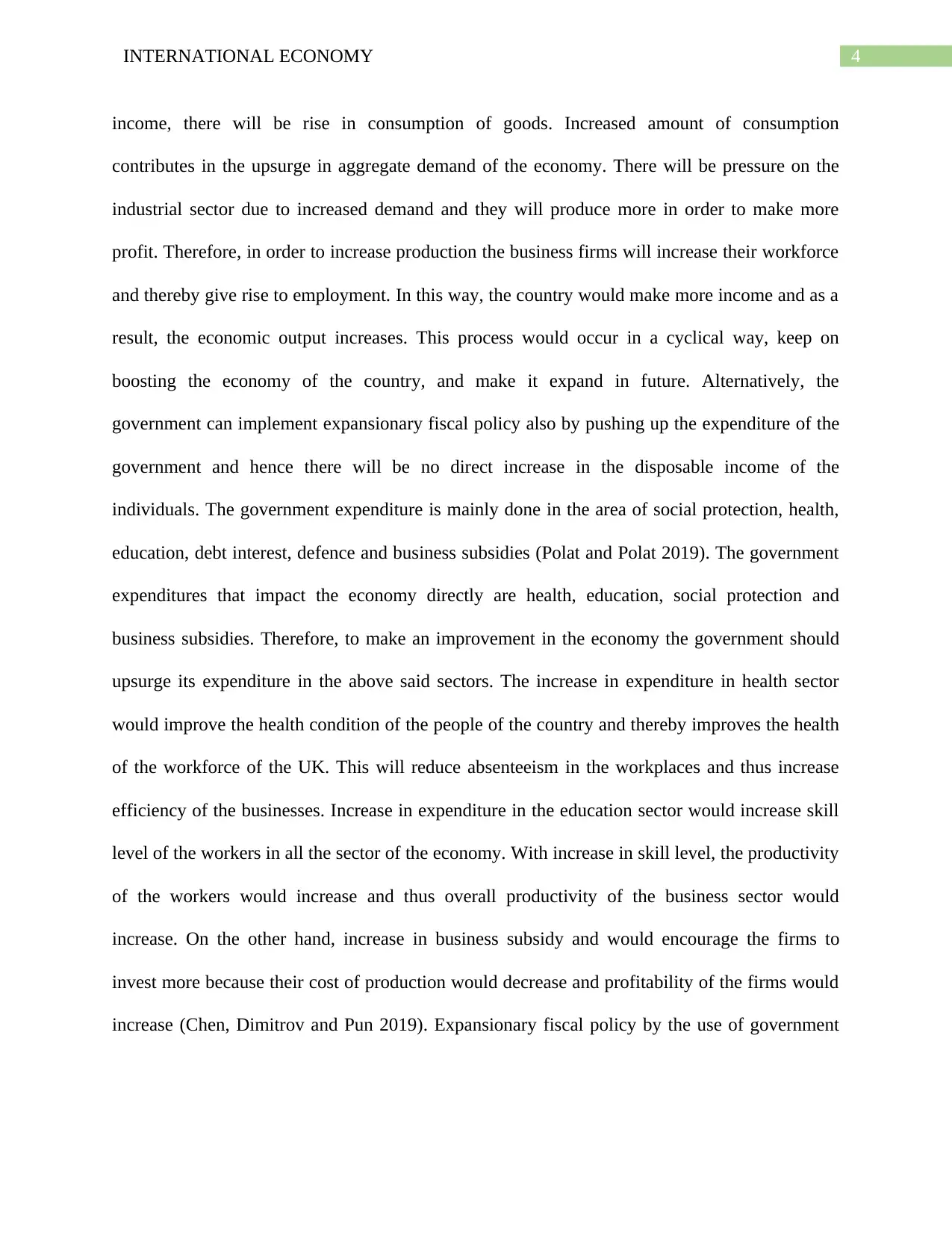
4INTERNATIONAL ECONOMY
income, there will be rise in consumption of goods. Increased amount of consumption
contributes in the upsurge in aggregate demand of the economy. There will be pressure on the
industrial sector due to increased demand and they will produce more in order to make more
profit. Therefore, in order to increase production the business firms will increase their workforce
and thereby give rise to employment. In this way, the country would make more income and as a
result, the economic output increases. This process would occur in a cyclical way, keep on
boosting the economy of the country, and make it expand in future. Alternatively, the
government can implement expansionary fiscal policy also by pushing up the expenditure of the
government and hence there will be no direct increase in the disposable income of the
individuals. The government expenditure is mainly done in the area of social protection, health,
education, debt interest, defence and business subsidies (Polat and Polat 2019). The government
expenditures that impact the economy directly are health, education, social protection and
business subsidies. Therefore, to make an improvement in the economy the government should
upsurge its expenditure in the above said sectors. The increase in expenditure in health sector
would improve the health condition of the people of the country and thereby improves the health
of the workforce of the UK. This will reduce absenteeism in the workplaces and thus increase
efficiency of the businesses. Increase in expenditure in the education sector would increase skill
level of the workers in all the sector of the economy. With increase in skill level, the productivity
of the workers would increase and thus overall productivity of the business sector would
increase. On the other hand, increase in business subsidy and would encourage the firms to
invest more because their cost of production would decrease and profitability of the firms would
increase (Chen, Dimitrov and Pun 2019). Expansionary fiscal policy by the use of government
income, there will be rise in consumption of goods. Increased amount of consumption
contributes in the upsurge in aggregate demand of the economy. There will be pressure on the
industrial sector due to increased demand and they will produce more in order to make more
profit. Therefore, in order to increase production the business firms will increase their workforce
and thereby give rise to employment. In this way, the country would make more income and as a
result, the economic output increases. This process would occur in a cyclical way, keep on
boosting the economy of the country, and make it expand in future. Alternatively, the
government can implement expansionary fiscal policy also by pushing up the expenditure of the
government and hence there will be no direct increase in the disposable income of the
individuals. The government expenditure is mainly done in the area of social protection, health,
education, debt interest, defence and business subsidies (Polat and Polat 2019). The government
expenditures that impact the economy directly are health, education, social protection and
business subsidies. Therefore, to make an improvement in the economy the government should
upsurge its expenditure in the above said sectors. The increase in expenditure in health sector
would improve the health condition of the people of the country and thereby improves the health
of the workforce of the UK. This will reduce absenteeism in the workplaces and thus increase
efficiency of the businesses. Increase in expenditure in the education sector would increase skill
level of the workers in all the sector of the economy. With increase in skill level, the productivity
of the workers would increase and thus overall productivity of the business sector would
increase. On the other hand, increase in business subsidy and would encourage the firms to
invest more because their cost of production would decrease and profitability of the firms would
increase (Chen, Dimitrov and Pun 2019). Expansionary fiscal policy by the use of government
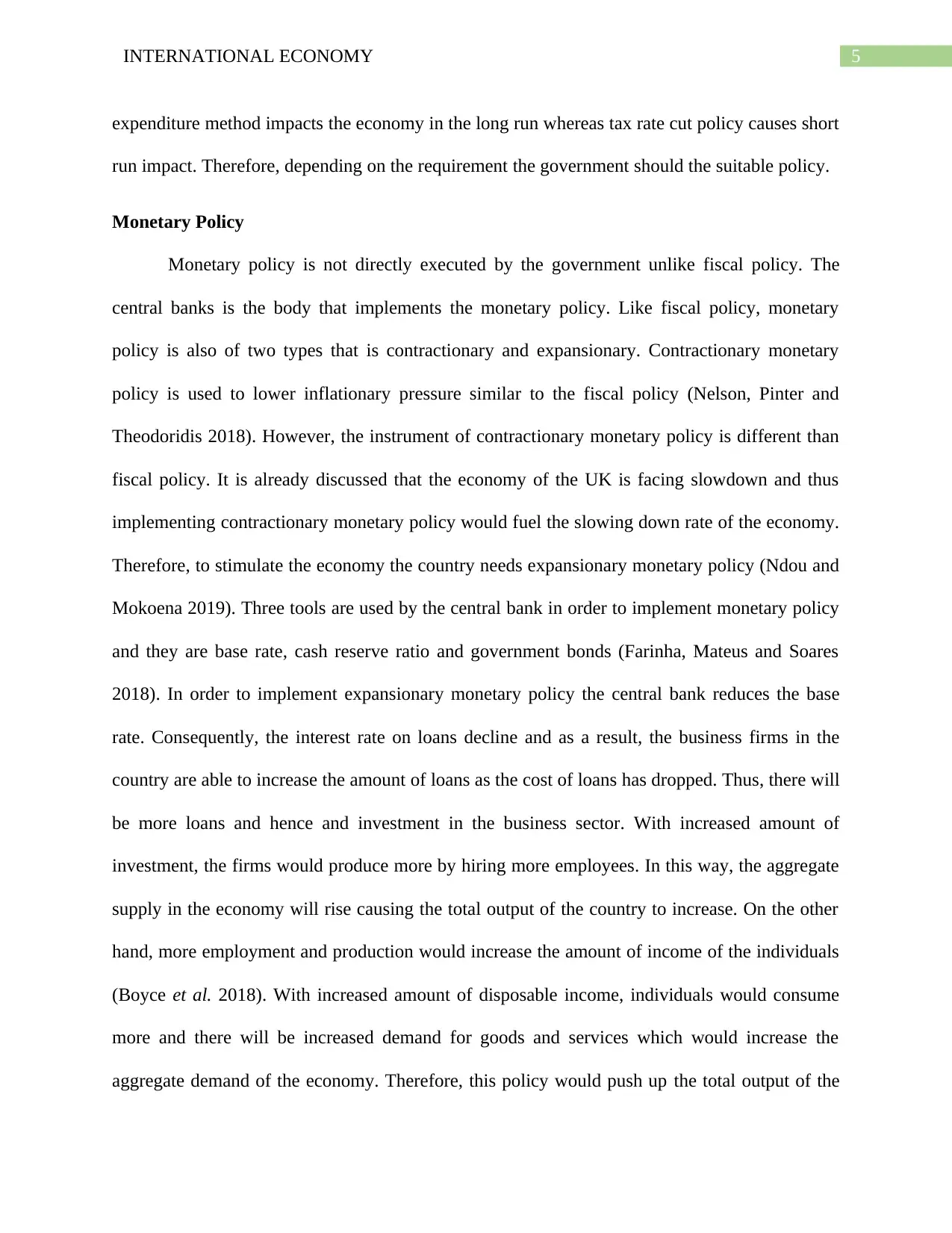
5INTERNATIONAL ECONOMY
expenditure method impacts the economy in the long run whereas tax rate cut policy causes short
run impact. Therefore, depending on the requirement the government should the suitable policy.
Monetary Policy
Monetary policy is not directly executed by the government unlike fiscal policy. The
central banks is the body that implements the monetary policy. Like fiscal policy, monetary
policy is also of two types that is contractionary and expansionary. Contractionary monetary
policy is used to lower inflationary pressure similar to the fiscal policy (Nelson, Pinter and
Theodoridis 2018). However, the instrument of contractionary monetary policy is different than
fiscal policy. It is already discussed that the economy of the UK is facing slowdown and thus
implementing contractionary monetary policy would fuel the slowing down rate of the economy.
Therefore, to stimulate the economy the country needs expansionary monetary policy (Ndou and
Mokoena 2019). Three tools are used by the central bank in order to implement monetary policy
and they are base rate, cash reserve ratio and government bonds (Farinha, Mateus and Soares
2018). In order to implement expansionary monetary policy the central bank reduces the base
rate. Consequently, the interest rate on loans decline and as a result, the business firms in the
country are able to increase the amount of loans as the cost of loans has dropped. Thus, there will
be more loans and hence and investment in the business sector. With increased amount of
investment, the firms would produce more by hiring more employees. In this way, the aggregate
supply in the economy will rise causing the total output of the country to increase. On the other
hand, more employment and production would increase the amount of income of the individuals
(Boyce et al. 2018). With increased amount of disposable income, individuals would consume
more and there will be increased demand for goods and services which would increase the
aggregate demand of the economy. Therefore, this policy would push up the total output of the
expenditure method impacts the economy in the long run whereas tax rate cut policy causes short
run impact. Therefore, depending on the requirement the government should the suitable policy.
Monetary Policy
Monetary policy is not directly executed by the government unlike fiscal policy. The
central banks is the body that implements the monetary policy. Like fiscal policy, monetary
policy is also of two types that is contractionary and expansionary. Contractionary monetary
policy is used to lower inflationary pressure similar to the fiscal policy (Nelson, Pinter and
Theodoridis 2018). However, the instrument of contractionary monetary policy is different than
fiscal policy. It is already discussed that the economy of the UK is facing slowdown and thus
implementing contractionary monetary policy would fuel the slowing down rate of the economy.
Therefore, to stimulate the economy the country needs expansionary monetary policy (Ndou and
Mokoena 2019). Three tools are used by the central bank in order to implement monetary policy
and they are base rate, cash reserve ratio and government bonds (Farinha, Mateus and Soares
2018). In order to implement expansionary monetary policy the central bank reduces the base
rate. Consequently, the interest rate on loans decline and as a result, the business firms in the
country are able to increase the amount of loans as the cost of loans has dropped. Thus, there will
be more loans and hence and investment in the business sector. With increased amount of
investment, the firms would produce more by hiring more employees. In this way, the aggregate
supply in the economy will rise causing the total output of the country to increase. On the other
hand, more employment and production would increase the amount of income of the individuals
(Boyce et al. 2018). With increased amount of disposable income, individuals would consume
more and there will be increased demand for goods and services which would increase the
aggregate demand of the economy. Therefore, this policy would push up the total output of the
⊘ This is a preview!⊘
Do you want full access?
Subscribe today to unlock all pages.

Trusted by 1+ million students worldwide
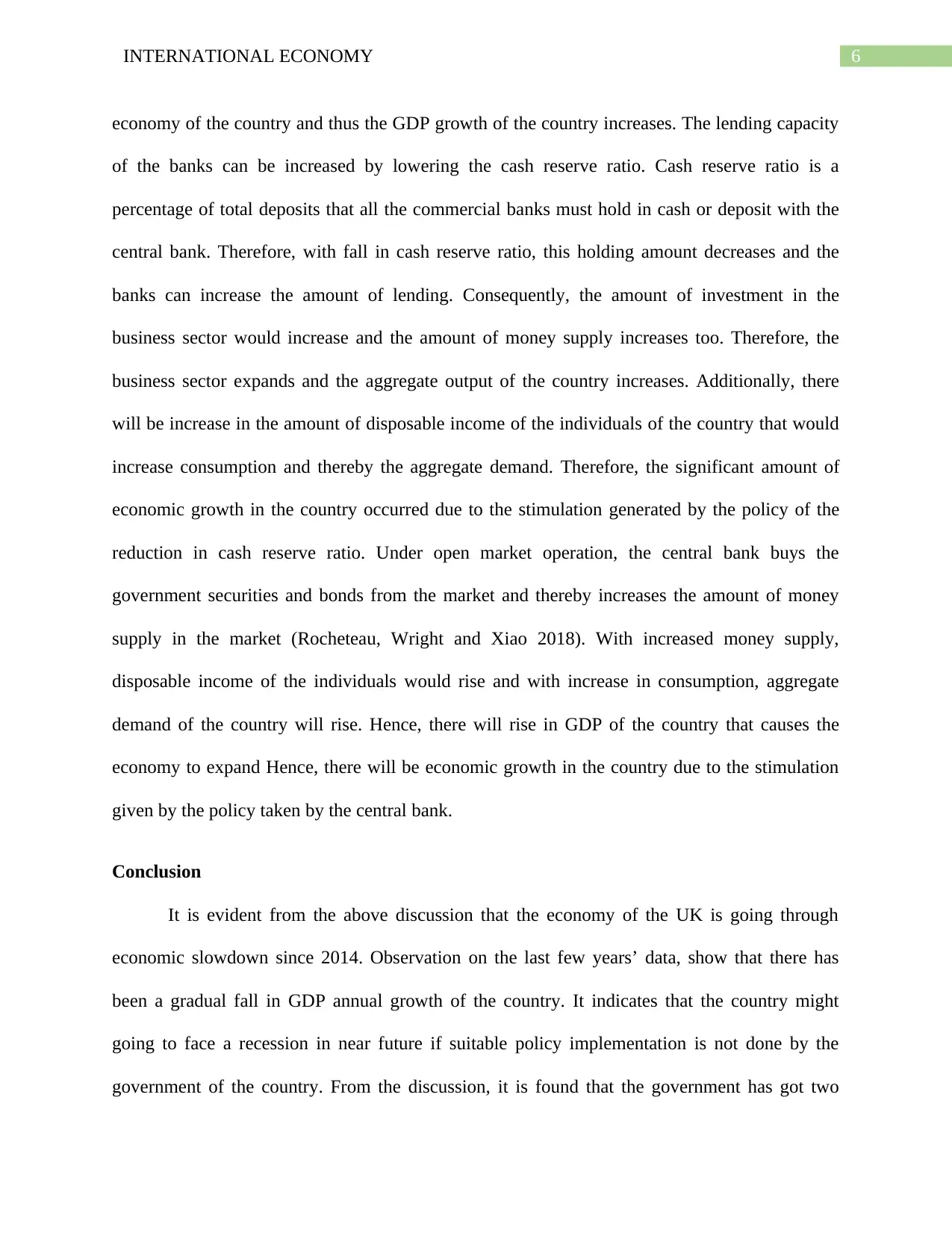
6INTERNATIONAL ECONOMY
economy of the country and thus the GDP growth of the country increases. The lending capacity
of the banks can be increased by lowering the cash reserve ratio. Cash reserve ratio is a
percentage of total deposits that all the commercial banks must hold in cash or deposit with the
central bank. Therefore, with fall in cash reserve ratio, this holding amount decreases and the
banks can increase the amount of lending. Consequently, the amount of investment in the
business sector would increase and the amount of money supply increases too. Therefore, the
business sector expands and the aggregate output of the country increases. Additionally, there
will be increase in the amount of disposable income of the individuals of the country that would
increase consumption and thereby the aggregate demand. Therefore, the significant amount of
economic growth in the country occurred due to the stimulation generated by the policy of the
reduction in cash reserve ratio. Under open market operation, the central bank buys the
government securities and bonds from the market and thereby increases the amount of money
supply in the market (Rocheteau, Wright and Xiao 2018). With increased money supply,
disposable income of the individuals would rise and with increase in consumption, aggregate
demand of the country will rise. Hence, there will rise in GDP of the country that causes the
economy to expand Hence, there will be economic growth in the country due to the stimulation
given by the policy taken by the central bank.
Conclusion
It is evident from the above discussion that the economy of the UK is going through
economic slowdown since 2014. Observation on the last few years’ data, show that there has
been a gradual fall in GDP annual growth of the country. It indicates that the country might
going to face a recession in near future if suitable policy implementation is not done by the
government of the country. From the discussion, it is found that the government has got two
economy of the country and thus the GDP growth of the country increases. The lending capacity
of the banks can be increased by lowering the cash reserve ratio. Cash reserve ratio is a
percentage of total deposits that all the commercial banks must hold in cash or deposit with the
central bank. Therefore, with fall in cash reserve ratio, this holding amount decreases and the
banks can increase the amount of lending. Consequently, the amount of investment in the
business sector would increase and the amount of money supply increases too. Therefore, the
business sector expands and the aggregate output of the country increases. Additionally, there
will be increase in the amount of disposable income of the individuals of the country that would
increase consumption and thereby the aggregate demand. Therefore, the significant amount of
economic growth in the country occurred due to the stimulation generated by the policy of the
reduction in cash reserve ratio. Under open market operation, the central bank buys the
government securities and bonds from the market and thereby increases the amount of money
supply in the market (Rocheteau, Wright and Xiao 2018). With increased money supply,
disposable income of the individuals would rise and with increase in consumption, aggregate
demand of the country will rise. Hence, there will rise in GDP of the country that causes the
economy to expand Hence, there will be economic growth in the country due to the stimulation
given by the policy taken by the central bank.
Conclusion
It is evident from the above discussion that the economy of the UK is going through
economic slowdown since 2014. Observation on the last few years’ data, show that there has
been a gradual fall in GDP annual growth of the country. It indicates that the country might
going to face a recession in near future if suitable policy implementation is not done by the
government of the country. From the discussion, it is found that the government has got two
Paraphrase This Document
Need a fresh take? Get an instant paraphrase of this document with our AI Paraphraser
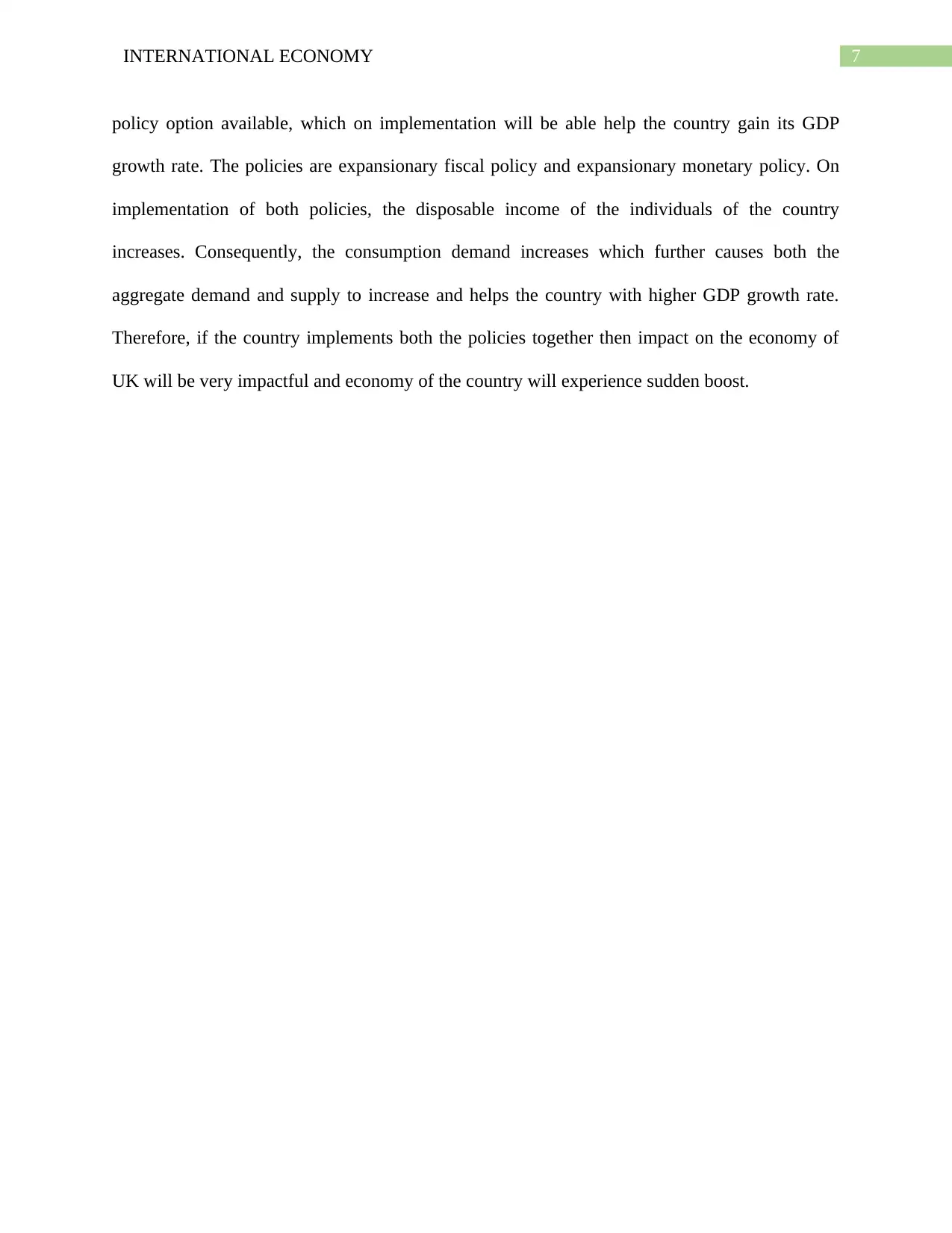
7INTERNATIONAL ECONOMY
policy option available, which on implementation will be able help the country gain its GDP
growth rate. The policies are expansionary fiscal policy and expansionary monetary policy. On
implementation of both policies, the disposable income of the individuals of the country
increases. Consequently, the consumption demand increases which further causes both the
aggregate demand and supply to increase and helps the country with higher GDP growth rate.
Therefore, if the country implements both the policies together then impact on the economy of
UK will be very impactful and economy of the country will experience sudden boost.
policy option available, which on implementation will be able help the country gain its GDP
growth rate. The policies are expansionary fiscal policy and expansionary monetary policy. On
implementation of both policies, the disposable income of the individuals of the country
increases. Consequently, the consumption demand increases which further causes both the
aggregate demand and supply to increase and helps the country with higher GDP growth rate.
Therefore, if the country implements both the policies together then impact on the economy of
UK will be very impactful and economy of the country will experience sudden boost.
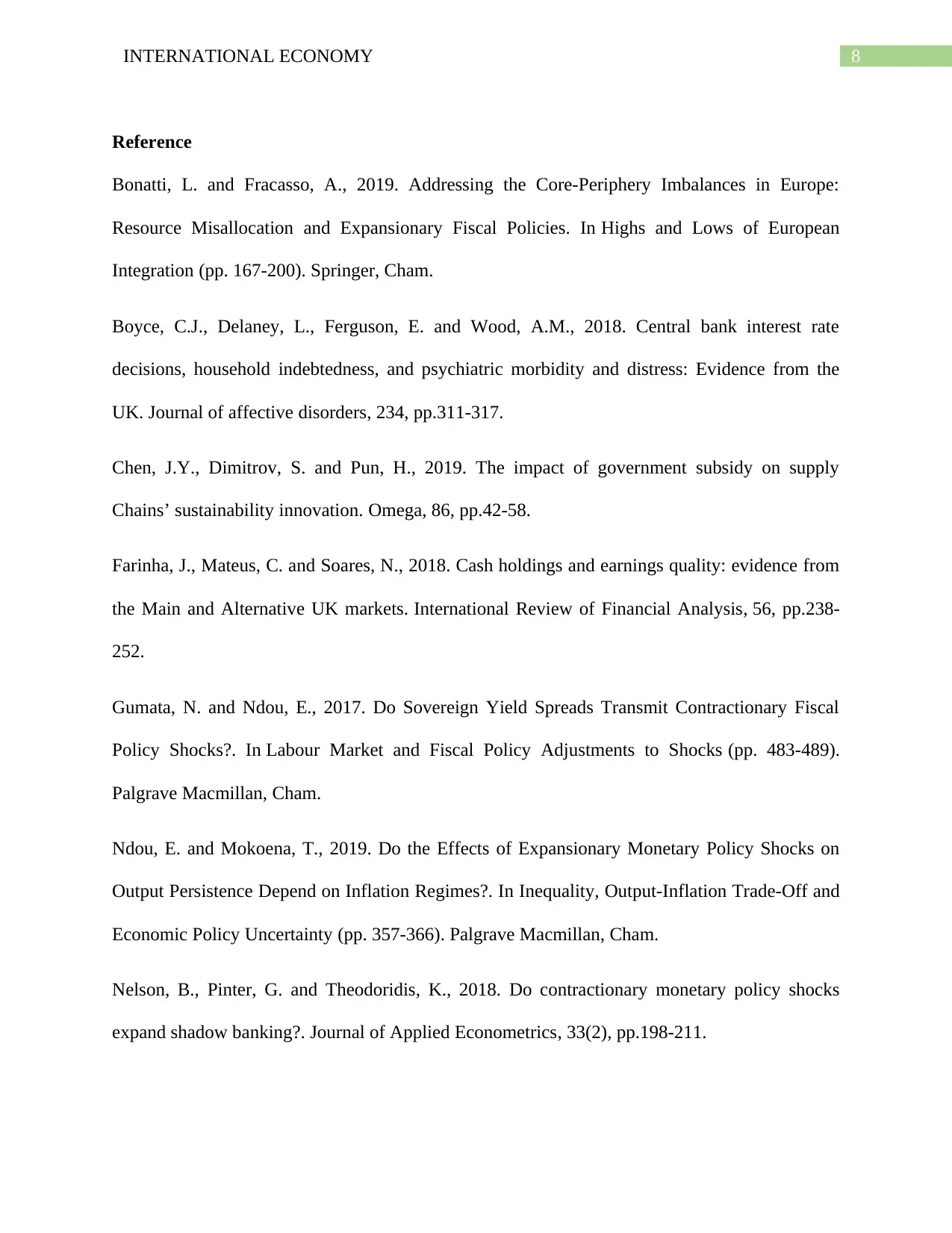
8INTERNATIONAL ECONOMY
Reference
Bonatti, L. and Fracasso, A., 2019. Addressing the Core-Periphery Imbalances in Europe:
Resource Misallocation and Expansionary Fiscal Policies. In Highs and Lows of European
Integration (pp. 167-200). Springer, Cham.
Boyce, C.J., Delaney, L., Ferguson, E. and Wood, A.M., 2018. Central bank interest rate
decisions, household indebtedness, and psychiatric morbidity and distress: Evidence from the
UK. Journal of affective disorders, 234, pp.311-317.
Chen, J.Y., Dimitrov, S. and Pun, H., 2019. The impact of government subsidy on supply
Chains’ sustainability innovation. Omega, 86, pp.42-58.
Farinha, J., Mateus, C. and Soares, N., 2018. Cash holdings and earnings quality: evidence from
the Main and Alternative UK markets. International Review of Financial Analysis, 56, pp.238-
252.
Gumata, N. and Ndou, E., 2017. Do Sovereign Yield Spreads Transmit Contractionary Fiscal
Policy Shocks?. In Labour Market and Fiscal Policy Adjustments to Shocks (pp. 483-489).
Palgrave Macmillan, Cham.
Ndou, E. and Mokoena, T., 2019. Do the Effects of Expansionary Monetary Policy Shocks on
Output Persistence Depend on Inflation Regimes?. In Inequality, Output-Inflation Trade-Off and
Economic Policy Uncertainty (pp. 357-366). Palgrave Macmillan, Cham.
Nelson, B., Pinter, G. and Theodoridis, K., 2018. Do contractionary monetary policy shocks
expand shadow banking?. Journal of Applied Econometrics, 33(2), pp.198-211.
Reference
Bonatti, L. and Fracasso, A., 2019. Addressing the Core-Periphery Imbalances in Europe:
Resource Misallocation and Expansionary Fiscal Policies. In Highs and Lows of European
Integration (pp. 167-200). Springer, Cham.
Boyce, C.J., Delaney, L., Ferguson, E. and Wood, A.M., 2018. Central bank interest rate
decisions, household indebtedness, and psychiatric morbidity and distress: Evidence from the
UK. Journal of affective disorders, 234, pp.311-317.
Chen, J.Y., Dimitrov, S. and Pun, H., 2019. The impact of government subsidy on supply
Chains’ sustainability innovation. Omega, 86, pp.42-58.
Farinha, J., Mateus, C. and Soares, N., 2018. Cash holdings and earnings quality: evidence from
the Main and Alternative UK markets. International Review of Financial Analysis, 56, pp.238-
252.
Gumata, N. and Ndou, E., 2017. Do Sovereign Yield Spreads Transmit Contractionary Fiscal
Policy Shocks?. In Labour Market and Fiscal Policy Adjustments to Shocks (pp. 483-489).
Palgrave Macmillan, Cham.
Ndou, E. and Mokoena, T., 2019. Do the Effects of Expansionary Monetary Policy Shocks on
Output Persistence Depend on Inflation Regimes?. In Inequality, Output-Inflation Trade-Off and
Economic Policy Uncertainty (pp. 357-366). Palgrave Macmillan, Cham.
Nelson, B., Pinter, G. and Theodoridis, K., 2018. Do contractionary monetary policy shocks
expand shadow banking?. Journal of Applied Econometrics, 33(2), pp.198-211.
⊘ This is a preview!⊘
Do you want full access?
Subscribe today to unlock all pages.

Trusted by 1+ million students worldwide
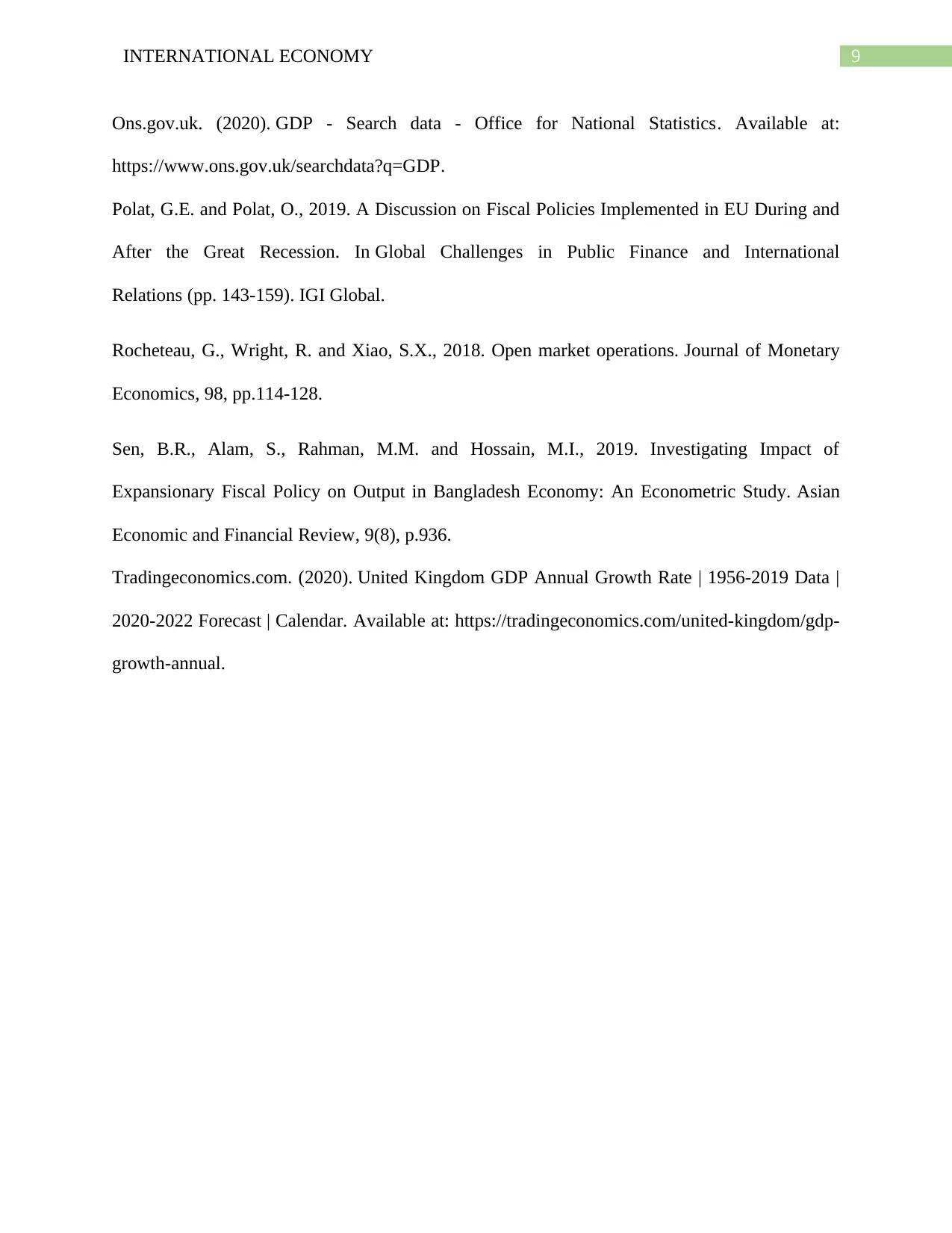
9INTERNATIONAL ECONOMY
Ons.gov.uk. (2020). GDP - Search data - Office for National Statistics. Available at:
https://www.ons.gov.uk/searchdata?q=GDP.
Polat, G.E. and Polat, O., 2019. A Discussion on Fiscal Policies Implemented in EU During and
After the Great Recession. In Global Challenges in Public Finance and International
Relations (pp. 143-159). IGI Global.
Rocheteau, G., Wright, R. and Xiao, S.X., 2018. Open market operations. Journal of Monetary
Economics, 98, pp.114-128.
Sen, B.R., Alam, S., Rahman, M.M. and Hossain, M.I., 2019. Investigating Impact of
Expansionary Fiscal Policy on Output in Bangladesh Economy: An Econometric Study. Asian
Economic and Financial Review, 9(8), p.936.
Tradingeconomics.com. (2020). United Kingdom GDP Annual Growth Rate | 1956-2019 Data |
2020-2022 Forecast | Calendar. Available at: https://tradingeconomics.com/united-kingdom/gdp-
growth-annual.
Ons.gov.uk. (2020). GDP - Search data - Office for National Statistics. Available at:
https://www.ons.gov.uk/searchdata?q=GDP.
Polat, G.E. and Polat, O., 2019. A Discussion on Fiscal Policies Implemented in EU During and
After the Great Recession. In Global Challenges in Public Finance and International
Relations (pp. 143-159). IGI Global.
Rocheteau, G., Wright, R. and Xiao, S.X., 2018. Open market operations. Journal of Monetary
Economics, 98, pp.114-128.
Sen, B.R., Alam, S., Rahman, M.M. and Hossain, M.I., 2019. Investigating Impact of
Expansionary Fiscal Policy on Output in Bangladesh Economy: An Econometric Study. Asian
Economic and Financial Review, 9(8), p.936.
Tradingeconomics.com. (2020). United Kingdom GDP Annual Growth Rate | 1956-2019 Data |
2020-2022 Forecast | Calendar. Available at: https://tradingeconomics.com/united-kingdom/gdp-
growth-annual.
1 out of 10
Related Documents
Your All-in-One AI-Powered Toolkit for Academic Success.
+13062052269
info@desklib.com
Available 24*7 on WhatsApp / Email
![[object Object]](/_next/static/media/star-bottom.7253800d.svg)
Unlock your academic potential
Copyright © 2020–2025 A2Z Services. All Rights Reserved. Developed and managed by ZUCOL.





